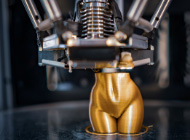
Creating a quality and aesthetic 3D object is not as easy as it may seem. From designing phase to printing, there are certain factors that should be considered. A specific 3D design can look beautiful on the computer but may result in terrible 3D part after printing.
Aside from that, there can be difficulties and issues that may be encountered during the printing process such as quality problems, fragile parts, low-resolution output and etc. These can hugely affect the final quality and appearance of the object. Having these issues can also be frustrating for designers and engineers.
It is important to make sure that before the 3D parts are created, the 3D designs must be printable. In order to avoid different mistakes and problems when printing 3D parts, here are some tips for designing 3D objects and parts.
1. Consider the printing material
Before designing any 3D parts, it is vital to know the basic guidelines of the printing materials to be used. There are specific characteristics of 3D printing material. It can be strong, flexible, smooth, highly resistant to heat, etc.
Make sure that the materials to be used are already defined so that it will be easier to design a 3D object. The choice of materials can affect certain aspects of the design. For instance, if the 3D part that is being designed is intended for mechanical purposes, they have to consider the material’s strength and flexibility in order to meet the desired specifications.
2. Printing technology used
After choosing the 3d printing material, make sure that which proper printing technology to be used should be identified. The material and printing technology should go hand in hand. For example, if a 3d designer is designing a 3D object with interlocking parts, it is best to use Alumide, ABS or Polyamide and not suitable for Silver, Gold or Resin. The reason behind this is not the material itself but the technology used for each material.
3. Try to avoid using support materials
In 3D printing, support structures are important to hold a design in place while printing. It acts as a scaffolding and prevents the filament from drooping during the entire printing process. After the 3d printing, supports are intended to be removed (either manually or with the use of chemical process) leaving the final look of the design.
Although supports are necessary, there are also many benefits to reducing supports while printing. Below are some of them.
- It can save time and money.
- It lessens errors and mistakes.
- It can create smoother finishes.
Moreover, the use of support material may lead to dimensional inaccuracies. Thus, it affects the quality of the final product. When designing, consider reducing the support materials for 3D objects.
4. Understand minimum wall thickness and file resolution
Some issues regarding 3D printing can be traced back to incorrect wall thickness. When designing, a minimum wall thickness is required. The minimum wall thickness should be about 0.2mm to 0.6mm for smaller 3D parts. For bigger parts, it can be increased for up to 0.6mm.
File resolution can also extremely affect the overall outcome of the 3D part. If the resolution is low, the final product may appear to be “pixelated”. Likewise, if the resolution is too high, it can be hard to handle and print the objects properly.
Thus, it is important to make sure that the wall thickness and file resolution are properly set while designing 3D parts.
5. Consider file export settings
Exporting the 3D designs is a crucial part of the 3D printing process. There are different file types for 3D printing. It can be IGES or Initial Graphics Exchange Specification, STEP or Standard for the Exchange of Product model data and STL (Stereolithography or Standard Tessellation Language)
From the types cited above, the most commonly used is STL. It is also the standard file type for exporting. As early as the designing stage, the export settings should be known because it can affect the printed parts. A typical STL file size can range from 200KB up to 10MB. The goal here is to generate a file that is small in size while maintaining its quality.
6. Go for simple models with small shapes first
For beginners, it is worthwhile to use small shapes such as rectangles, circles triangles, etc. on your designs. It can be a little hard to start immediately with difficult forms and designs. Working with small shapes can also reduce 3d printing mistakes and issues. Once you know how to work with simpler shapes, it can be a lot easier to deal with more complex and advanced shapes in the future.
Conclusion
In order to have good and high-quality 3D printed objects/parts, it is necessary to learn these designing tips into consideration and apply them into practices. Just make sure to research in advanced to gain more knowledge on how 3D printing works.
Designing 3D parts on your own can be challenging. However, if you need some professional help, you can contact a reputable 3D printing service provider today. They can provide good services such as 3D design and modelling, custom 3D printing and many more which can help you print 3d products successfully.








